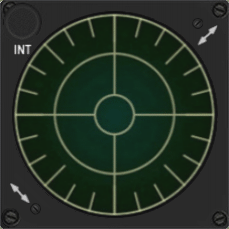Project introduction

| RADAR WARNING RECEIVER indicator project
Project introduction |
 |
At the left side of the Center Console is the RWR (RADAR Warning Receiver). This item is not easy to find, and if you do, the trick is
of course how to interface the CRT (Cathode Ray Tube) and associated electronic circuits. As it turns out, the yoke (containing the
coils to position the electron beam to a point on the screen is not quite the same as the yoke on the good 'ol television set tube
(before the TFT and plasma screens). The webpage of Mike Powell's
RWR project is great reading stuff,
and in fact was what got me going. However, I consider the chances of obtaining an original F-16 RWR display unit for not too much
money very slim.
 As an electronics hobbyist and HAM radio amateur I often see old oscilloscopes for sale for as little as 30 euros.
As an electronics hobbyist and HAM radio amateur I often see old oscilloscopes for sale for as little as 30 euros.
The cheap scopes have a "small" approximately 3" round CRT, and that is exactly what you can use for the RWR display! An other
nice aspect when you re-use an old scope is that all the stuff around the CRT, such as deflection amplifiers and (not to forget)
the high voltage power supply are already there! That also takes care of the more complex deflection system that Mike had to
interface: electrostatic deflection is easier than coil-based deflection. And another bonus is that the electrostatic deflection does
not generate much heat like the coil-driving output stages.
So, what would be against using an old oscilloscope? I guess, nothing. You just need to get one with a 3" round screen which,
preferably, lights a green trace ... those are the easiest to find! The only thing you have to do is dismantle the scope, and it
would really help if you can find the schematic diagram, but that is not a must; just make a lot of notes while disassembling.
This webpage is sort-of a logbook where I write down my thoughts (perhaps to amuse others with my "crazy" ideas), and as such will
report the progress (if any) made on this project. I like to have several projects at hand, so at times this webpage may not be
updated for a few months ...
It is a good idea to think of a design how to develop the software and to consider what is needed. By thinking about that in advance you can come up with a good design in stead of a "kludge that works". One day, you might need to correct a bug and then the effort will pay off. Maintenance is important; I know that the software will probably have a few obscure hidden bugs to bite me, and hardware will do funny, not anticipated things!
Some calculations to see if the resolution will be acceptable.
The screen diameter is 3", approximately 76 mm. Note that the screen is round, so the "edges" of a square box area will "fall off"
the screen. With 8 bit resolution of the DACs you can generate 256 discrete positions. This means that in the middle of the screen
the length of a line from left edge to right edge is 76 mm drawn with 256 dots. 76 mm / 256 gives a dot every ~0.3 mm which seems OK.
It takes time to calculate and draw a dot on the screen. Some symbols are built using more dots than others, but a certain amount of symbols must be drawn in 20 ms to prevent the flicker effect of screen update. What performance is acceptable needs to be determined. At first, no optimizations will be done in the software; first goal is to get it working! If performance is an issue, code optimization may be a solution, else a faster PIC must be chosen.
Click on the folder at the left of the RWR indicator link. A tree opens with links to the hardware page and software page.